'People will forgive you for being wrong, but they will never forgive you for being right - especially if events prove you right while proving them wrong.' Thomas Sowell
Search This Blog
Showing posts with label recipe. Show all posts
Showing posts with label recipe. Show all posts
Wednesday, 30 August 2023
Monday, 6 May 2013
A Diet for those who love to eat and wish to lose weight
The 5:2 diet – feasts for fast days
With its flexible approach and simple rules, the 5:2 diet has become the calorie-control plan for people who like to eat
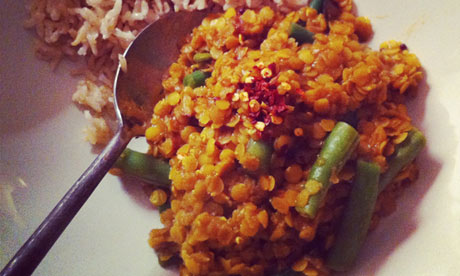
The fasting diet, otherwise known as the 5:2, restricts calories for two days a week. Photograph: Felicity Cloake
For the first time since university I am on a diet. Somehow, I've become a calorie-counter, someone who weighs out porridge oats and drinks herbal tea. In other words, the kind of person I've always pitied.
- Tell us what you think: Star-rate and review this book
The thing is, I'm actually quite enjoying it – enjoying being a relative term, of course. In an ideal world, I'd boast the kind of robust metabolism that laughs in the face of cooking six bakewell tarts an afternoon, but I don't. And since I started my Perfect recipe column a couple of years ago, I've noticed the pounds slowly creeping on. There's a lot to love about my job, but it does make it almost impossible to eat healthily.
The fasting diet, otherwise known as the 5:2 because of the format – five days of normal eating a week and two in which you restrict your calories (500kcal for women, 600kcal for men) – seemed to offer a glimmer of hope for my hips. It's basically the diet for people who like food. Everyone from Hugh Fearnley-Whittingstallto wine writer Fiona Beckett has been boring on about fast days, and if they could do it, well, so could I.
So far, I've managed two months. As someone who's never made a habit of weighing themselves, I can only tell you that I think I've lost about 10lb since I started, which includes a two-week period over Easter where I gave myself a bit of a break, but only put back on 1lb.
The odd thing was, after Easter I was impatient to get going again. The 5:2 already feels like a long-term project. It's not difficult to stick to either. After all, if you really want a biscuit, you can always have one tomorrow – a thought I find extremely cheering.
Many people I've spoken to seem to avoid cooking at all on a fast day, reasoning perhaps that it simply puts temptation in their way. Indeed, in her book, the Fast Diet, co-authored with Dr Michael Mosley, whose 2012 BBC Horizon programme on fasting kickstarted interest in the idea, Mimi Spencer advises preparing food in advance, and keeping it simple, "aiming for fast-day flavour without effort".
I couldn't disagree more. For me, the challenge of devising satisfying recipes that fit within the daily 500-kcal limit has kept fast days interesting, and frankly, if you're only going to be eating two small meals a day, heating them up in the microwave makes things even more depressing. Here are a few tips I've found useful so far, and three of my favourite fast-day recipes …
• Low-calorie cooking is all about strong flavours: pungent spices, zesty lemon juice and salty soy sauce will all help to distract your attention from the missing calories, as will lots of garlic and big handfuls of fresh herbs.
• Don't be too hard on yourself. Usually I sniffily avoid artificial sweeteners, but a cold glass of slimline tonic with a slice of lime and plenty of ice goes down a treat when everyone else is glugging wine. I've even been known to indulge in a low-calorie pot of jelly when I'm feeling particularly wild.
• Carbs are rarely worth the calories. A paltry 50g of brown rice takes up over a third of your daily calorie count. Save them for tomorrow and fill up on vegetables and berries instead.
• Pickles such as gherkins (14kcal per 100g) and miso soups (20-30kcal a cup) are your friends for snacks.
• Drink lots. Sparkling water, evil diet drinks and weird and wonderful teas will keep you occupied mid-afternoon.
• Embrace your inner nerd and invest in a set of electronic scales and a calorie-counting book or app, or you'll find it impossible to measure your intake accurately.
Thursday, 11 August 2011
Is Hummus a near-sacred foodstuff, or a bland, beige paste with good PR?
How to make perfect hummus
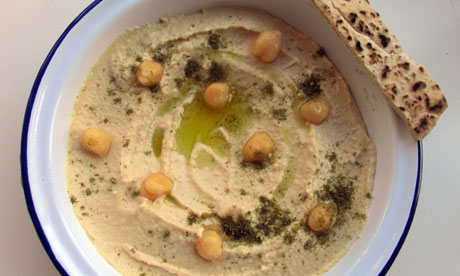
Felicity's perfect hummus. Photograph: Felicity Cloake for the Guardian
Whatever happened to the dip? Once the apogee of sophisticated entertaining in their dinky quartered tubs, these gloopy mixtures – thousand island, cheese and chive, the graveyard of a million splintered Pringles – were quietly dethroned, sometime in the late 1990s, by an invasion from the eastern Mediterranean: salmon pink taramasalata, garlicky tzatziki and, most successful of all, hummus, the colour and texture of wet mortar. Suddenly, the world went beige.
Of course, it wasn't long before we made hummus our own, adding sweet chilli sauce, pesto, sun-dried tomatoes – in fact, the chickpea has good-naturedly absorbed well-nigh every food fad that's gripped the nation over the last decade – but despite its popularity, very few of us actually make our own. Which is a shame, because fresh hummus is a world away from the sour slurry, seasoned with preservatives, and solid enough to retile the bathroom with, sold under the name in many supermarkets – and half the price too.
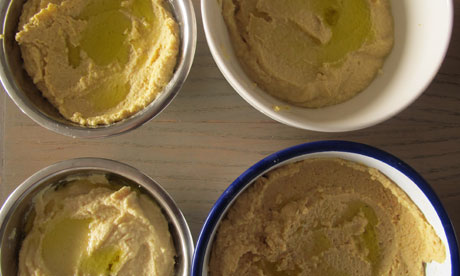 Claudia Roden's hummus recipe with (clockwise from top left), tinned, dried, jarred and skinned tinned chickpeas. Photograph: Felicity Cloake for the Guardian However, in the interests of lazy cooks everywhere, I'm making two identical hummuses from Claudia Roden's recipe in Arabesque – one using dried chickpeas, as she directs, and one with a tin from the cupboard. The dried chickpeas definitely have a nuttier flavour (although, having helped myself to a few, I reject the idea that the others are actively unpleasant), but they also give the hummus a grainier texture. I've obviously been lucky with my tin; according to complaints online, many brands are crunchy and undercooked, whereas the Italian ones sold by my local (Turkish) grocer are fast approaching mushy.
Claudia Roden's hummus recipe with (clockwise from top left), tinned, dried, jarred and skinned tinned chickpeas. Photograph: Felicity Cloake for the Guardian However, in the interests of lazy cooks everywhere, I'm making two identical hummuses from Claudia Roden's recipe in Arabesque – one using dried chickpeas, as she directs, and one with a tin from the cupboard. The dried chickpeas definitely have a nuttier flavour (although, having helped myself to a few, I reject the idea that the others are actively unpleasant), but they also give the hummus a grainier texture. I've obviously been lucky with my tin; according to complaints online, many brands are crunchy and undercooked, whereas the Italian ones sold by my local (Turkish) grocer are fast approaching mushy.
Flavourwise though, I need to trade up, which is where Lebanese food writer Anissa Helou comes in. Although she decries such conveniences in her 2003 book, Lebanese Cuisine ("I do not like the taste or texture of tinned food"), by 2007's Modern Mezze, her attitude has relented: "I used to make hommus the old-fashioned slow way … However, you can now buy jars of excellent ready-cooked chickpeas, preserved in water and salt, without added artificial preservatives".
I find some in my local overpriced organic supermarket, modestly priced at just £2.99 for 425g – but I can at least see the difference. They're double the size of the tinned sort, and the hummus I make with them is buttery and smooth, with what my flatmate describes in a forced blind tasting as a "lovely flavour". If you're going to cheat, do it properly.
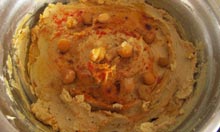 Ottolenghi recipe hummus. Photograph: Felicity Cloake for the Guardian Everyone else, from Anissa Helou to Yotam Ottolenghi, recommends adding a little bicarbonate of soda to the soaking water: this time-honoured trick, according to kitchen chemistry whizz Hervé This, prevents the calcium in my London tapwater from cementing together the pectin molecules in the pea's cell walls – in fact, the alkaline water that it produces actively encourages these pectins to separate, producing a softening effect (I recommend a perusal of This's Kitchen Mysteries for a more coherent scientific explanation).
Ottolenghi recipe hummus. Photograph: Felicity Cloake for the Guardian Everyone else, from Anissa Helou to Yotam Ottolenghi, recommends adding a little bicarbonate of soda to the soaking water: this time-honoured trick, according to kitchen chemistry whizz Hervé This, prevents the calcium in my London tapwater from cementing together the pectin molecules in the pea's cell walls – in fact, the alkaline water that it produces actively encourages these pectins to separate, producing a softening effect (I recommend a perusal of This's Kitchen Mysteries for a more coherent scientific explanation).
Ottolenghi uses 1½ tbsp bicarb per 500g dried chickpeas: 1 tbsp in the soaking water, and the rest in the pan. After the same soaking period as Roden's, his chickpeas take a quarter of the time to cook – and achieve that lovely fluffy texture which makes such great hummus. Nigella, meanwhile, who makes a very sensible point about the global conspiracy to pretend chickpeas cook far quicker than they do (see also, risotto), uses a slightly different method, credited to her mentor, Anna del Conte.
She soaks the dried chickpeas in cold water and a mixture of bicarb, flour and salt – the last, according to Harold McGee, speeds the eventual cooking time, but reduces the swelling of starch granules within the beans, giving a "mealy internal texture, rather than a smooth one", but the rationale behind the flour I'm unable to fathom. In any case, Nigella's chickpeas take very slightly longer than Ottolenghi's, and have a slightly grittier texture, so I'll trust the latter on this one.
(Two points to note – too much bicarb can give the chickpeas an unpleasant soapy quality, so always err on the side of caution. It's also been suggested that it robs them of much of their nutritional value, but I couldn't find any data on this, or what effect the alternative, a much lengthier cooking time, has: all information most welcome.)
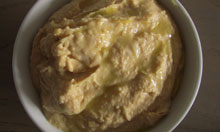 Paula Wolfert hummus. Photograph: Felicity Cloake for the Guardian While trawling through reams of hummus lore online, I come across Paula Wolfert's claim that, during an assignment on "the best hummus in Israel", she discovered that peeling chickpeas gave a "superior colour and flavour" to the end product. The fact that chickpeas even had skins was news for me, but they're actually very easy to slip off, once the chickpeas are cooked; although given the size of the things, it's a mindless, rhythmic activity for a night in front of the telly. I don't like the texture it gives Roden's recipe though – hummus varies from chunky to silken smooth, and this is too far down the latter road to for my taste; more like a mousse than a dip.
Paula Wolfert hummus. Photograph: Felicity Cloake for the Guardian While trawling through reams of hummus lore online, I come across Paula Wolfert's claim that, during an assignment on "the best hummus in Israel", she discovered that peeling chickpeas gave a "superior colour and flavour" to the end product. The fact that chickpeas even had skins was news for me, but they're actually very easy to slip off, once the chickpeas are cooked; although given the size of the things, it's a mindless, rhythmic activity for a night in front of the telly. I don't like the texture it gives Roden's recipe though – hummus varies from chunky to silken smooth, and this is too far down the latter road to for my taste; more like a mousse than a dip.
Wolfert also passes on a tip she picked up on her trip: mixing the tahini with lemon juice and garlic until it "tightens up", and then loosening it with cold water before stirring it into the hummus – a move intended to create a lighter, creamier texture. She's right on this one – it makes a subtle, but discernible difference, preventing the clagginess that sometimes dogs this dip.
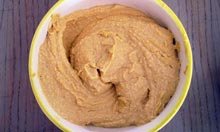 Nigella recipe hummus. Photograph: Felicity Cloake for the Guardian Nigella's basic recipe, however, is interesting in that it's lightened with Greek yoghurt – "as far as authenticity goes, I don't make any claims," she admits, but "homemade hummus can be stodgy and claggy, and I love the tender whippedness that you get in restaurant versions". I agree – it adds richness without weight, but after experimenting, I discover a similar texture can be achieved through judicious application of chickpea cooking water.
Nigella recipe hummus. Photograph: Felicity Cloake for the Guardian Nigella's basic recipe, however, is interesting in that it's lightened with Greek yoghurt – "as far as authenticity goes, I don't make any claims," she admits, but "homemade hummus can be stodgy and claggy, and I love the tender whippedness that you get in restaurant versions". I agree – it adds richness without weight, but after experimenting, I discover a similar texture can be achieved through judicious application of chickpea cooking water.
I don't think you need the olive oil Nigella adds either; I prefer to keep mine as a topping, to be soaked up by the pitta – but one innovation I will be keeping is her pinch of cumin. It's not a standard ingredient, although by no means unknown in the Middle East, but it makes a real difference to the end result.
The balance of garlic and lemon juice is very personal, but I'd stick with the ratio of tahini to chickpea given here: too much of the sesame seed paste gives a sticky, sweet result – I think even Ottolenghi overplays it. As my tester observes, hummus ought to taste of chickpeas.
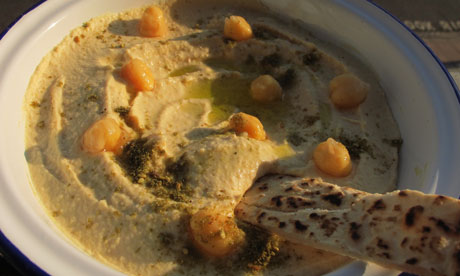 Felicity's perfect hummus. Photograph: Felicity Cloake for the Guardian Hummus may be simple, but that doesn't mean it's easy – there's an awful lot of disappointing dips out there. Take time to cook the chickpeas properly, and season ever-so-gradually, until the heat of the garlic, and the zing of the lemon suits your particular idea of perfection, and you'll remember just why this unassuming Middle Eastern staple stole our hearts in the first place.
Felicity's perfect hummus. Photograph: Felicity Cloake for the Guardian Hummus may be simple, but that doesn't mean it's easy – there's an awful lot of disappointing dips out there. Take time to cook the chickpeas properly, and season ever-so-gradually, until the heat of the garlic, and the zing of the lemon suits your particular idea of perfection, and you'll remember just why this unassuming Middle Eastern staple stole our hearts in the first place.
Serves 4
200g dried chickpeas
1½ tsp bicarbonate of soda
6 tbsp tahini
Juice of 1 lemon, or more to taste
3 cloves garlic, crushed, or according to taste
Pinch of cumin
Salt, to taste
Olive oil, to top
Paprika or za'tar, to top (optional)
1. Put the chickpeas in a bowl and cover with twice the volume of cold water. Stir in 1 tsp of bicarbonate of soda and leave to soak for 24 hours.
2. Drain the chickpeas, rinse well and put in a large pan. Cover with cold water and add the rest of the bicarb. Bring to the boil, then turn down the heat and simmer gently until they're tender – they need to be easy to mush, and almost falling apart, which will take between 1 and 4 hours depending on your chickpeas. Add more hot water if they seem to be boiling dry.
3. Leave them to cool in the water, and then drain well, reserving the cooking liquid, and setting aside a spoonful of chickpeas as a garnish. Mix the tahini with half the lemon juice and half the crushed garlic – it should tighten up – then stir in enough cooled cooking liquid to make a loose paste. Add this, and the chickpeas, to a food processor and whizz to make a purée.
4. Add the cumin and a generous pinch of salt, then gradually tip in enough cooking water to give a soft paste – it should just hold its shape, but not be claggy. Taste, and add more lemon juice, garlic or salt according to taste.
5. Tip into a bowl, and when ready to serve, drizzle with olive oil, garnish with the reserved chickpeas and sprinkle with paprika or za'tar if using.
Is hummus a near-sacred foodstuff, or a bland, beige paste with good PR? Will anyone come out in favour of tinned chickpeas – or exotic flavourings? – and please, what on earth should I do with 8 bowls of the stuff?
Of course, it wasn't long before we made hummus our own, adding sweet chilli sauce, pesto, sun-dried tomatoes – in fact, the chickpea has good-naturedly absorbed well-nigh every food fad that's gripped the nation over the last decade – but despite its popularity, very few of us actually make our own. Which is a shame, because fresh hummus is a world away from the sour slurry, seasoned with preservatives, and solid enough to retile the bathroom with, sold under the name in many supermarkets – and half the price too.
Chickpeas in our time: tinned v dried v posh
The beauty of hummus, as far as I'm concerned, is how easy it is to sling together at the last minute from the cupboard – a tin of chickpeas, a spoonful of tahini, some lemon juice and garlic, and you've got the makings of lunch … as well as plenty of time to reflect upon your sins in using such inferior produce, because no true hummus head can abide tins. They're all wrong texturally, apparently, and the flavour … well, according to blogger Helen Graves, they "pong" to boot. Well, that's me told. Claudia Roden's hummus recipe with (clockwise from top left), tinned, dried, jarred and skinned tinned chickpeas. Photograph: Felicity Cloake for the Guardian However, in the interests of lazy cooks everywhere, I'm making two identical hummuses from Claudia Roden's recipe in Arabesque – one using dried chickpeas, as she directs, and one with a tin from the cupboard. The dried chickpeas definitely have a nuttier flavour (although, having helped myself to a few, I reject the idea that the others are actively unpleasant), but they also give the hummus a grainier texture. I've obviously been lucky with my tin; according to complaints online, many brands are crunchy and undercooked, whereas the Italian ones sold by my local (Turkish) grocer are fast approaching mushy.
Claudia Roden's hummus recipe with (clockwise from top left), tinned, dried, jarred and skinned tinned chickpeas. Photograph: Felicity Cloake for the Guardian However, in the interests of lazy cooks everywhere, I'm making two identical hummuses from Claudia Roden's recipe in Arabesque – one using dried chickpeas, as she directs, and one with a tin from the cupboard. The dried chickpeas definitely have a nuttier flavour (although, having helped myself to a few, I reject the idea that the others are actively unpleasant), but they also give the hummus a grainier texture. I've obviously been lucky with my tin; according to complaints online, many brands are crunchy and undercooked, whereas the Italian ones sold by my local (Turkish) grocer are fast approaching mushy. Flavourwise though, I need to trade up, which is where Lebanese food writer Anissa Helou comes in. Although she decries such conveniences in her 2003 book, Lebanese Cuisine ("I do not like the taste or texture of tinned food"), by 2007's Modern Mezze, her attitude has relented: "I used to make hommus the old-fashioned slow way … However, you can now buy jars of excellent ready-cooked chickpeas, preserved in water and salt, without added artificial preservatives".
I find some in my local overpriced organic supermarket, modestly priced at just £2.99 for 425g – but I can at least see the difference. They're double the size of the tinned sort, and the hummus I make with them is buttery and smooth, with what my flatmate describes in a forced blind tasting as a "lovely flavour". If you're going to cheat, do it properly.
Secret (softening) agents
The problem with Roden's chickpeas may well be that, despite lengthy pre-soaking (28 hours, in fact), and four hours of cooking to render them edible, they're just not soft enough. I suspect my local shop, which bills itself as a Mediterranean Supermarket, has quite a high turnover in the dried chickpea department, but the fact remains that, without a pressure cooker, melting softness can be quite difficult to achieve – and it's absolutely vital for good hummus. Ottolenghi recipe hummus. Photograph: Felicity Cloake for the Guardian Everyone else, from Anissa Helou to Yotam Ottolenghi, recommends adding a little bicarbonate of soda to the soaking water: this time-honoured trick, according to kitchen chemistry whizz Hervé This, prevents the calcium in my London tapwater from cementing together the pectin molecules in the pea's cell walls – in fact, the alkaline water that it produces actively encourages these pectins to separate, producing a softening effect (I recommend a perusal of This's Kitchen Mysteries for a more coherent scientific explanation).
Ottolenghi recipe hummus. Photograph: Felicity Cloake for the Guardian Everyone else, from Anissa Helou to Yotam Ottolenghi, recommends adding a little bicarbonate of soda to the soaking water: this time-honoured trick, according to kitchen chemistry whizz Hervé This, prevents the calcium in my London tapwater from cementing together the pectin molecules in the pea's cell walls – in fact, the alkaline water that it produces actively encourages these pectins to separate, producing a softening effect (I recommend a perusal of This's Kitchen Mysteries for a more coherent scientific explanation). Ottolenghi uses 1½ tbsp bicarb per 500g dried chickpeas: 1 tbsp in the soaking water, and the rest in the pan. After the same soaking period as Roden's, his chickpeas take a quarter of the time to cook – and achieve that lovely fluffy texture which makes such great hummus. Nigella, meanwhile, who makes a very sensible point about the global conspiracy to pretend chickpeas cook far quicker than they do (see also, risotto), uses a slightly different method, credited to her mentor, Anna del Conte.
She soaks the dried chickpeas in cold water and a mixture of bicarb, flour and salt – the last, according to Harold McGee, speeds the eventual cooking time, but reduces the swelling of starch granules within the beans, giving a "mealy internal texture, rather than a smooth one", but the rationale behind the flour I'm unable to fathom. In any case, Nigella's chickpeas take very slightly longer than Ottolenghi's, and have a slightly grittier texture, so I'll trust the latter on this one.
(Two points to note – too much bicarb can give the chickpeas an unpleasant soapy quality, so always err on the side of caution. It's also been suggested that it robs them of much of their nutritional value, but I couldn't find any data on this, or what effect the alternative, a much lengthier cooking time, has: all information most welcome.)
Two top tips
 Paula Wolfert hummus. Photograph: Felicity Cloake for the Guardian While trawling through reams of hummus lore online, I come across Paula Wolfert's claim that, during an assignment on "the best hummus in Israel", she discovered that peeling chickpeas gave a "superior colour and flavour" to the end product. The fact that chickpeas even had skins was news for me, but they're actually very easy to slip off, once the chickpeas are cooked; although given the size of the things, it's a mindless, rhythmic activity for a night in front of the telly. I don't like the texture it gives Roden's recipe though – hummus varies from chunky to silken smooth, and this is too far down the latter road to for my taste; more like a mousse than a dip.
Paula Wolfert hummus. Photograph: Felicity Cloake for the Guardian While trawling through reams of hummus lore online, I come across Paula Wolfert's claim that, during an assignment on "the best hummus in Israel", she discovered that peeling chickpeas gave a "superior colour and flavour" to the end product. The fact that chickpeas even had skins was news for me, but they're actually very easy to slip off, once the chickpeas are cooked; although given the size of the things, it's a mindless, rhythmic activity for a night in front of the telly. I don't like the texture it gives Roden's recipe though – hummus varies from chunky to silken smooth, and this is too far down the latter road to for my taste; more like a mousse than a dip. Wolfert also passes on a tip she picked up on her trip: mixing the tahini with lemon juice and garlic until it "tightens up", and then loosening it with cold water before stirring it into the hummus – a move intended to create a lighter, creamier texture. She's right on this one – it makes a subtle, but discernible difference, preventing the clagginess that sometimes dogs this dip.
Flavourings
Although I'm not averse to abusing the chickpea's easy-going nature on occasion (I can particularly recommend the carrot and cardamom hummus from Alice Hart's new book, Vegetarian), here I'm sticking to the time-honoured quartet of chickpeas, tahini, lemon juice and garlic – no peanut butter, Nigella, and no dried mint thank you Elizabeth David. Nigella recipe hummus. Photograph: Felicity Cloake for the Guardian Nigella's basic recipe, however, is interesting in that it's lightened with Greek yoghurt – "as far as authenticity goes, I don't make any claims," she admits, but "homemade hummus can be stodgy and claggy, and I love the tender whippedness that you get in restaurant versions". I agree – it adds richness without weight, but after experimenting, I discover a similar texture can be achieved through judicious application of chickpea cooking water.
Nigella recipe hummus. Photograph: Felicity Cloake for the Guardian Nigella's basic recipe, however, is interesting in that it's lightened with Greek yoghurt – "as far as authenticity goes, I don't make any claims," she admits, but "homemade hummus can be stodgy and claggy, and I love the tender whippedness that you get in restaurant versions". I agree – it adds richness without weight, but after experimenting, I discover a similar texture can be achieved through judicious application of chickpea cooking water. I don't think you need the olive oil Nigella adds either; I prefer to keep mine as a topping, to be soaked up by the pitta – but one innovation I will be keeping is her pinch of cumin. It's not a standard ingredient, although by no means unknown in the Middle East, but it makes a real difference to the end result.
The balance of garlic and lemon juice is very personal, but I'd stick with the ratio of tahini to chickpea given here: too much of the sesame seed paste gives a sticky, sweet result – I think even Ottolenghi overplays it. As my tester observes, hummus ought to taste of chickpeas.
How to top it
Hummus is, of course, ideal dipping material, but it can also be dressed up into a proper meal – Ottolenghi's recipe in Plenty has it with broad bean paste, hard-boiled eggs and raw onion (not "the lightest affair, but … completely delicious"), while the recipe in the Moro cookbook includes a sweetly spiced topping of minced lamb, caramelised onions and pine nuts, which I urge you to try. Even if you're serving it as a dip, a sprinkling of paprika, or (my own personal favourite), lemony za'tar, sets it well apart from the common supermarket herd.Perfect hummus
 Felicity's perfect hummus. Photograph: Felicity Cloake for the Guardian Hummus may be simple, but that doesn't mean it's easy – there's an awful lot of disappointing dips out there. Take time to cook the chickpeas properly, and season ever-so-gradually, until the heat of the garlic, and the zing of the lemon suits your particular idea of perfection, and you'll remember just why this unassuming Middle Eastern staple stole our hearts in the first place.
Felicity's perfect hummus. Photograph: Felicity Cloake for the Guardian Hummus may be simple, but that doesn't mean it's easy – there's an awful lot of disappointing dips out there. Take time to cook the chickpeas properly, and season ever-so-gradually, until the heat of the garlic, and the zing of the lemon suits your particular idea of perfection, and you'll remember just why this unassuming Middle Eastern staple stole our hearts in the first place.Serves 4
200g dried chickpeas
1½ tsp bicarbonate of soda
6 tbsp tahini
Juice of 1 lemon, or more to taste
3 cloves garlic, crushed, or according to taste
Pinch of cumin
Salt, to taste
Olive oil, to top
Paprika or za'tar, to top (optional)
1. Put the chickpeas in a bowl and cover with twice the volume of cold water. Stir in 1 tsp of bicarbonate of soda and leave to soak for 24 hours.
2. Drain the chickpeas, rinse well and put in a large pan. Cover with cold water and add the rest of the bicarb. Bring to the boil, then turn down the heat and simmer gently until they're tender – they need to be easy to mush, and almost falling apart, which will take between 1 and 4 hours depending on your chickpeas. Add more hot water if they seem to be boiling dry.
3. Leave them to cool in the water, and then drain well, reserving the cooking liquid, and setting aside a spoonful of chickpeas as a garnish. Mix the tahini with half the lemon juice and half the crushed garlic – it should tighten up – then stir in enough cooled cooking liquid to make a loose paste. Add this, and the chickpeas, to a food processor and whizz to make a purée.
4. Add the cumin and a generous pinch of salt, then gradually tip in enough cooking water to give a soft paste – it should just hold its shape, but not be claggy. Taste, and add more lemon juice, garlic or salt according to taste.
5. Tip into a bowl, and when ready to serve, drizzle with olive oil, garnish with the reserved chickpeas and sprinkle with paprika or za'tar if using.
Is hummus a near-sacred foodstuff, or a bland, beige paste with good PR? Will anyone come out in favour of tinned chickpeas – or exotic flavourings? – and please, what on earth should I do with 8 bowls of the stuff?
- © 2011 Guardian News and Media Limited or its affiliated companies. All rights reserved.
Monday, 4 July 2011
Spicy beef burger
Ingredients
450g/16oz lean beef mince
2 garlic cloves, crushed
1 tsp tomato ketchup
1 tsp mustard
1 egg, lightly beaten
1 red chilli, finely chopped
1 small onion, finely diced
2 spring onions, sliced
handful basil leaves, chopped
olive oil for frying
Preparation method
1. In a large bowl mix together the mince, garlic, tomato ketchup,
mustard, egg, chilli and onion.
2. Dive in with your hands and mix until the ingredients are well
blended.
3. Just before cooking, add the spring onions and basil to the mixture
and divide into four patties.
4. Heat a little olive oil in a large non-stick frying pan and fry the
burgers.
5. Turn them once only, cooking for about 5-6 minutes each side.
(Alternatively you can cook them under a grill for the same time
turning half way through.)
6. Serve with burger buns and salad.
450g/16oz lean beef mince
2 garlic cloves, crushed
1 tsp tomato ketchup
1 tsp mustard
1 egg, lightly beaten
1 red chilli, finely chopped
1 small onion, finely diced
2 spring onions, sliced
handful basil leaves, chopped
olive oil for frying
Preparation method
1. In a large bowl mix together the mince, garlic, tomato ketchup,
mustard, egg, chilli and onion.
2. Dive in with your hands and mix until the ingredients are well
blended.
3. Just before cooking, add the spring onions and basil to the mixture
and divide into four patties.
4. Heat a little olive oil in a large non-stick frying pan and fry the
burgers.
5. Turn them once only, cooking for about 5-6 minutes each side.
(Alternatively you can cook them under a grill for the same time
turning half way through.)
6. Serve with burger buns and salad.
Novak Djokovic's recipe for success
Wimbledon 2011: Novak Djokovic's recipe for success
Page last updated at
16:12 GMT, Sunday, 3 July 2011 17:12 UK
By David Ornstein
BBC Sport at Wimbledon
Wimbledon Championships
Venue: All England Club, London Date: 20 June-3 July Coverage: Live on BBC One, Two, 3D, HD, Red Button, online (UK only), Radio 5 live, 5 live sports extra; live text commentary from 0900 BST on BBC Sport website (#bbctennis); watch again on iPlayer
Djokovic too good for spirited Tsonga (UK only)
Novak Djokovic's progress to the Wimbledon final means he will become the new world number one when the next ATP rankings are released on Monday.
The 24-year-old's rise to the summit of men's tennis owes much to an incredible 43-match unbeaten streak, which spanned six months, seven tournaments and started in December last year.
It came to an end with defeat by Roger Federer at the French Open, but marked a remarkable turnaround for a player who struggled badly for much of 2010 - winning only two of 19 tournaments all season.
Djokovic's SW19 run has extended his 2011 win-loss record to 48-1 after his four-set victory over Rafael Nadal in Sunday's showpiece.
But what sparked the improvement and why is he so much better in 2011? BBC Sport spoke to Marian Vajda, a former world number 34 and the Serbian's coach since 2006.
HOW DO YOU REFLECT ON NOVAK'S WINNING SEQUENCE?
"Special, wonderful, amazing - there aren't enough superlatives to describe how this year has been for him, and for us as his team. It shows we're doing a good job and we should celebrate and admire what has happened. Since I started working with him in 2006 this has been his goal.
Continue reading the main story
We found he had a gluten allergy and since he's cut that out of his diet, he is able to breathe better and take in more oxygen. His body is much healthier and this is the key
Marian Vajda
"He found a way to play the guys, learned how to beat them, how to prepare properly, how to handle the pressure. It's a process. Before, he had lapses, nerves, we could see he often couldn't handle the pressure. Physically he was not good. Now, he's 24 years old, much stronger and his talent is coming to the surface.
"Unfortunately the loss to Federer ended his unbeaten run and stopped him from becoming world number one, so that was bitter and took away some mental strength. But my role as his coach was to get him to try to forget this defeat and prepare as well as possible for Wimbledon."
WHAT HAS HE DONE DIFFERENTLY TO MAKE SUCH A DRASTIC STEP UP?
"There was a tough period in his tennis career when, in 2009, he decided he wanted to switch to working with two coaches. Todd Martin came in, changed a couple of techniques and his serve was not working well.
Vajda (second from right) has worked with Djokovic since 2006 "At the start of 2010, he was in serious trouble. He managed to win a few matches and stay in the world's top three, but he had no serve. He had to get back to his old routines. In men's tennis, the serve is the number one issue. We worked hard and about 12 months ago he started to improve, but he was still far away from where he is now.
"You can see his serve is much better and he is so confident now that he tends to win the most important points - break points, match points etc. At the start of this year he began winning matches in straight sets, dropping very few games and even in the giant battles against Nadal and Federer he was able to dominate, which rarely happened in 2010."
WAS THERE ANYTHING ELSE YOU PAID SPECIAL ATTENTION TO?
"Yes, we also worked hard on the physical side. Novak needed to improve his endurance. He was not able to stay on the court for a long time. He would manage five sets but it would take a lot of energy away from him for the next match. Now he's able to maintain that because he's far better technically and physically.
"We did a lot of running and a bike work but, in addition, he improved his health. We found he had a gluten allergy and since he's cut that out of his diet, he is able to breathe better and take in more oxygen. His body is much healthier and this is the key.
"But most of all, when you have a good serve you shorten games and hold easily - and that makes you stronger mentally. There are still areas to work on - he can improve his approach to and position at the net - but he's getting better and better."
HOW PLEASED WERE YOU WITH HIS PREPARATION FOR WIMBLEDON?
"Novak recovered really well from Paris. He went straight to Monte Carlo to be with his girlfriend Jelena for a couple of days - to have some time off, relax, do different things that would take his mind completely away from tennis.
Final dream 'comes true' for Djokovic (UK only)
"He went to the beach, did some swimming, saw his family and helped Jelena ahead of her graduation for an economics diploma on Sunday 12 June. Then we came over and practised at Aorangi for the first time on Monday 13 June.
"From the moment he stepped on to the grass he looked unbelievable. He played two practice sets against Richard Gasquet at an incredibly high level, as if Wimbledon was only two days away.
"In his only pre-Wimbledon warm-up match, against Gilles Simon, it was scary how good he was. He was relaxed and looking happier on grass than ever before. That made me feel pretty confident.
"The Federer defeat was bitter but champions like Novak realise that it's no shame to lose matches like that and unbeaten runs have to come to an end. Emotionally it stayed with him for a while, but he's experienced enough to get over it and regain his focus. To become world number one was something we were all focused on achieving. We prepared in a very professional way. He was ready.
WHY IS THIS TOURNAMENT SO SPECIAL TO NOVAK?
"It's a tradition. As a young kid, everyone watches Wimbledon. When I was a young kid I remember when we didn't have that much sport on TV, but we always had Wimbledon.
"You want to reach for that trophy, you want to see it high above your shoulders. This is the most exciting moment of your career. You work for this. It's the biggest tournament in the world. The history, the tradition, the champions. It's unique."
DID YOU FEEL HE ARRIVED AT SW19 UNDER LESS PRESSURE?
"Yes, and I was really pleased about that. The unbeaten run coming to an end released him. This was the tournament for Andy Murray, for Federer, for Rafael Nadal. Rafa was defending champion and had to defend all his ranking points from last year.
"Novak recovered well and came here in good condition, but we knew the relative lack of pressure could help him go far."
Page last updated at
16:12 GMT, Sunday, 3 July 2011 17:12 UK
By David Ornstein
BBC Sport at Wimbledon
Wimbledon Championships
Venue: All England Club, London Date: 20 June-3 July Coverage: Live on BBC One, Two, 3D, HD, Red Button, online (UK only), Radio 5 live, 5 live sports extra; live text commentary from 0900 BST on BBC Sport website (#bbctennis); watch again on iPlayer
Djokovic too good for spirited Tsonga (UK only)
Novak Djokovic's progress to the Wimbledon final means he will become the new world number one when the next ATP rankings are released on Monday.
The 24-year-old's rise to the summit of men's tennis owes much to an incredible 43-match unbeaten streak, which spanned six months, seven tournaments and started in December last year.
It came to an end with defeat by Roger Federer at the French Open, but marked a remarkable turnaround for a player who struggled badly for much of 2010 - winning only two of 19 tournaments all season.
Djokovic's SW19 run has extended his 2011 win-loss record to 48-1 after his four-set victory over Rafael Nadal in Sunday's showpiece.
But what sparked the improvement and why is he so much better in 2011? BBC Sport spoke to Marian Vajda, a former world number 34 and the Serbian's coach since 2006.
HOW DO YOU REFLECT ON NOVAK'S WINNING SEQUENCE?
"Special, wonderful, amazing - there aren't enough superlatives to describe how this year has been for him, and for us as his team. It shows we're doing a good job and we should celebrate and admire what has happened. Since I started working with him in 2006 this has been his goal.
Continue reading the main story
We found he had a gluten allergy and since he's cut that out of his diet, he is able to breathe better and take in more oxygen. His body is much healthier and this is the key
Marian Vajda
"He found a way to play the guys, learned how to beat them, how to prepare properly, how to handle the pressure. It's a process. Before, he had lapses, nerves, we could see he often couldn't handle the pressure. Physically he was not good. Now, he's 24 years old, much stronger and his talent is coming to the surface.
"Unfortunately the loss to Federer ended his unbeaten run and stopped him from becoming world number one, so that was bitter and took away some mental strength. But my role as his coach was to get him to try to forget this defeat and prepare as well as possible for Wimbledon."
WHAT HAS HE DONE DIFFERENTLY TO MAKE SUCH A DRASTIC STEP UP?
"There was a tough period in his tennis career when, in 2009, he decided he wanted to switch to working with two coaches. Todd Martin came in, changed a couple of techniques and his serve was not working well.
Vajda (second from right) has worked with Djokovic since 2006 "At the start of 2010, he was in serious trouble. He managed to win a few matches and stay in the world's top three, but he had no serve. He had to get back to his old routines. In men's tennis, the serve is the number one issue. We worked hard and about 12 months ago he started to improve, but he was still far away from where he is now.
"You can see his serve is much better and he is so confident now that he tends to win the most important points - break points, match points etc. At the start of this year he began winning matches in straight sets, dropping very few games and even in the giant battles against Nadal and Federer he was able to dominate, which rarely happened in 2010."
WAS THERE ANYTHING ELSE YOU PAID SPECIAL ATTENTION TO?
"Yes, we also worked hard on the physical side. Novak needed to improve his endurance. He was not able to stay on the court for a long time. He would manage five sets but it would take a lot of energy away from him for the next match. Now he's able to maintain that because he's far better technically and physically.
"We did a lot of running and a bike work but, in addition, he improved his health. We found he had a gluten allergy and since he's cut that out of his diet, he is able to breathe better and take in more oxygen. His body is much healthier and this is the key.
"But most of all, when you have a good serve you shorten games and hold easily - and that makes you stronger mentally. There are still areas to work on - he can improve his approach to and position at the net - but he's getting better and better."
HOW PLEASED WERE YOU WITH HIS PREPARATION FOR WIMBLEDON?
"Novak recovered really well from Paris. He went straight to Monte Carlo to be with his girlfriend Jelena for a couple of days - to have some time off, relax, do different things that would take his mind completely away from tennis.
Final dream 'comes true' for Djokovic (UK only)
"He went to the beach, did some swimming, saw his family and helped Jelena ahead of her graduation for an economics diploma on Sunday 12 June. Then we came over and practised at Aorangi for the first time on Monday 13 June.
"From the moment he stepped on to the grass he looked unbelievable. He played two practice sets against Richard Gasquet at an incredibly high level, as if Wimbledon was only two days away.
"In his only pre-Wimbledon warm-up match, against Gilles Simon, it was scary how good he was. He was relaxed and looking happier on grass than ever before. That made me feel pretty confident.
"The Federer defeat was bitter but champions like Novak realise that it's no shame to lose matches like that and unbeaten runs have to come to an end. Emotionally it stayed with him for a while, but he's experienced enough to get over it and regain his focus. To become world number one was something we were all focused on achieving. We prepared in a very professional way. He was ready.
WHY IS THIS TOURNAMENT SO SPECIAL TO NOVAK?
"It's a tradition. As a young kid, everyone watches Wimbledon. When I was a young kid I remember when we didn't have that much sport on TV, but we always had Wimbledon.
"You want to reach for that trophy, you want to see it high above your shoulders. This is the most exciting moment of your career. You work for this. It's the biggest tournament in the world. The history, the tradition, the champions. It's unique."
DID YOU FEEL HE ARRIVED AT SW19 UNDER LESS PRESSURE?
"Yes, and I was really pleased about that. The unbeaten run coming to an end released him. This was the tournament for Andy Murray, for Federer, for Rafael Nadal. Rafa was defending champion and had to defend all his ranking points from last year.
"Novak recovered well and came here in good condition, but we knew the relative lack of pressure could help him go far."
Subscribe to:
Comments (Atom)

